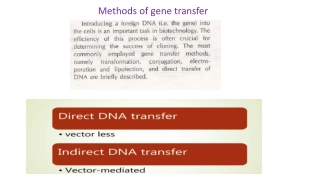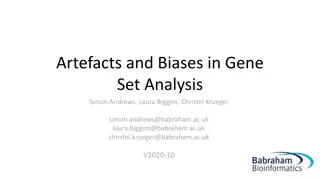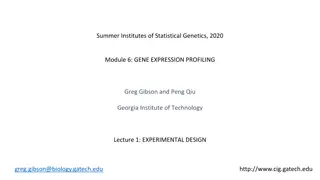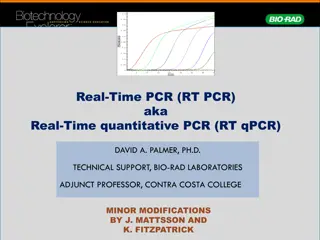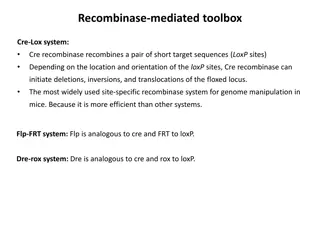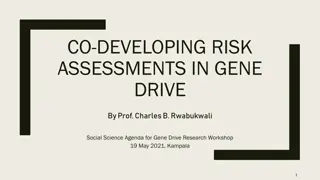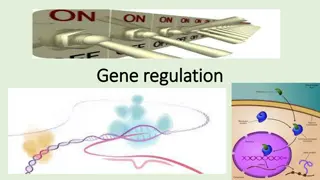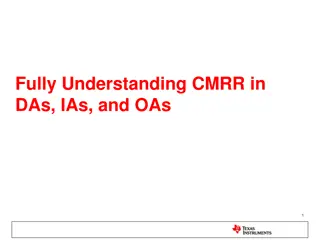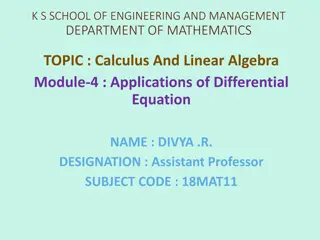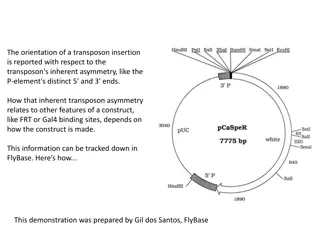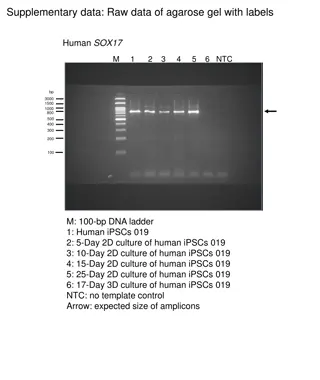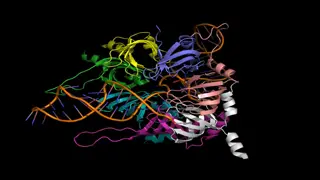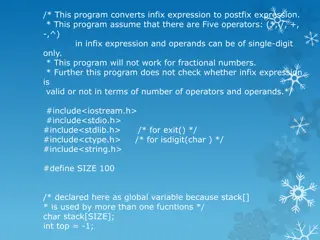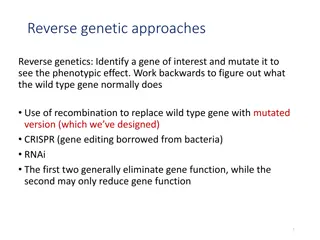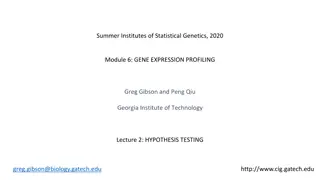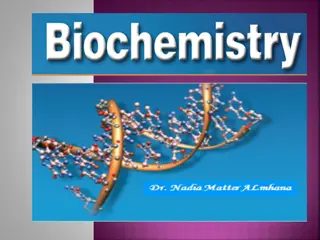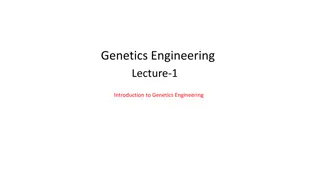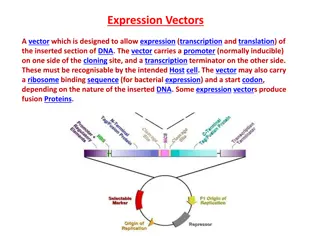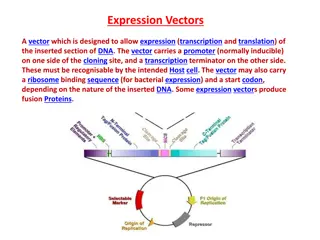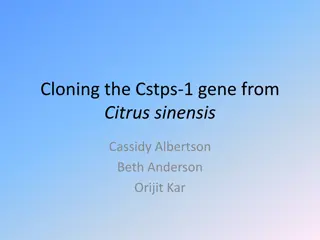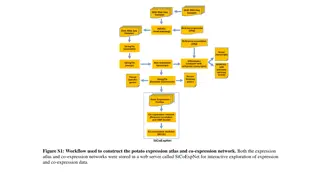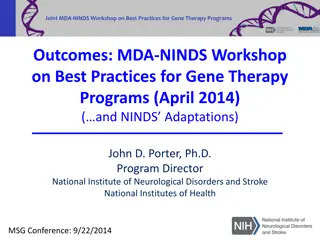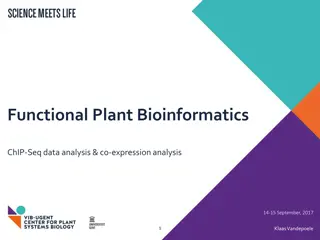Overview of Gene Transfer Methods in Molecular Biology
Explore various physical and chemical methods used for gene transfer, including electroporation, particle bombardment, microinjection, ultrasound, and bacterial transformation. Learn how DNA enters the nucleus and the role of retroviruses in gene transfer efficiency. Understand the process of RNA co
0 views • 17 slides
Gene Therapy and Genome Editing Technology
This article provides insights into the status, regulatory considerations, and delivery methods of gene therapy and genome editing technologies. It discusses approved gene therapies in the US, human genome editing in clinical applications, and the regulatory authority of the FDA over gene therapy. T
2 views • 27 slides
Understanding Gene Expression Regulation in Prokaryotes and Eukaryotes
Gene expression is a crucial process that leads to the production of functional gene products like RNA and proteins. This article explores the regulation of gene expression in both prokaryotes and eukaryotes, covering the importance of regulating gene expression, types of regulation elements, specif
5 views • 22 slides
Bioinformatics for Genomics Lecture Series 2022 Overview
Delve into the Genetics and Genome Evolution (GGE) Bioinformatics for Genomics Lecture Series 2022 presented by Sven Bergmann. Explore topics like RNA-seq, differential expression analysis, clustering, gene expression data analysis, epigenetic data analysis, integrative analysis, CHIP-seq, HiC data,
0 views • 36 slides
Understanding Artefacts and Biases in Gene Set Analysis
Gene set enrichment tests help identify functional gene sets enriched in hit lists compared to background sets. Various biases (technical, biological, statistical) can lead to incorrect conclusions in data analysis, emphasizing the importance of recognizing and addressing them. Technical biases like
0 views • 29 slides
Exploring Genetics and Genomics in Integrative Biology
Delve into the world of genetics and genomics through the lens of integrative biology, investigating the differences between cell types, the rationale for gene expression profiling, and the analysis of differential gene expression in various diseases. Uncover the significance of gene ontology, co-ex
0 views • 22 slides
Understanding Epigenetics: DNA Methylation and Histone Modification
Epigenetics involves modifications that impact gene expression without altering DNA sequences, playing a crucial role in the transition from genotype to phenotype. This includes DNA methylation, histone modification, and microRNAs. DNA methylation, controlled by DNMT enzymes, can lead to either gene
5 views • 12 slides
Understanding WBC Differential Count in Blood Analysis
WBC (white blood cell) count is essential in assessing a patient's health. A differential count helps determine the percentage of different types of white blood cells. This analysis can provide important insights into various health conditions like infections, allergies, and systemic illnesses. The
1 views • 9 slides
Gene Expression Profiling in Statistical Genetics Summer Institute 2020
This content provides information on the Summer Institutes of Statistical Genetics module, focusing on gene expression profiling. It includes details on the schedule, experimental design, RNA sequencing workflow, modes of bulk RNA sequencing, and RNASeq software. The content discusses crucial steps
0 views • 11 slides
Understanding Real-Time PCR and its Applications
Real-Time PCR, also known as quantitative PCR, is a specialized technique used in molecular biology for gene expression analysis, medical research, disease diagnosis, viral quantification, and more. It enables the real-time visualization and measurement of DNA sequences in a sample, playing a crucia
4 views • 8 slides
Understanding Differential Equations: Types, Classification, and Solutions
Differential equations are mathematical equations that relate independent and dependent variables through differential coefficients. They can be classified as ordinary or partial, based on the types of derivatives involved. The order and degree of a differential equation, as well as its linearity an
2 views • 26 slides
Understanding Differential Equations in Economics Honours
Differential equations, introduced by Newton and Leibniz in the 17th century, play a key role in economics. These equations involve derivatives and represent implicit functional relationships between variables and their differentials, often related to time functions. The order and degree of a differ
1 views • 16 slides
Introduction to Differential Equations and Laplace Equations
Understanding differential equations of various orders, solving methods, linear and non-linear equations, ordinary and partial differential equations, definitions of solutions, and general vs. particular solutions in the context of Differential Equations and Laplace Equations.
1 views • 20 slides
Understanding Gene Mutations in Molecular Biology
Gene mutations play a significant role in molecular biology, leading to alterations in DNA sequences that can impact offspring. These mutations can arise spontaneously or be induced by various factors, such as mutagens. Understanding gene mutations is crucial for comprehending the genetic basis of c
2 views • 27 slides
Understanding the Cre-Lox System for Genome Manipulation in Mice
The Cre-Lox system, a powerful tool in genetic engineering, employs Cre recombinase to recombine specific DNA sequences (LoxP sites), allowing for precise genetic modifications such as deletions, inversions, and translocations. This system enables conditional gene expression, turning on or off trans
4 views • 9 slides
Co-Developing Risk Assessments in Gene Drive
Gene drive technology is a cutting-edge approach aimed at combating malaria by spreading genetically modified genes in mosquito populations. This technology has the potential to protect endangered species and conserve nature. However, successful implementation requires complex collaborations, risk a
2 views • 16 slides
Understanding Gene Therapy: Types, Techniques, and Applications
Gene therapy involves introducing DNA into a patient to treat genetic diseases by correcting disease-causing mutations. There are two types of gene therapy: somatic gene therapy and germline gene therapy, each with different implications. Techniques such as gene augmentation therapy and gene inhibit
0 views • 15 slides
Understanding Gene Regulation and Control of Gene Expression
This comprehensive content delves into the intricate mechanisms of gene regulation and control of gene expression. It covers topics such as transcriptional regulation, bacterial genes classification, and the role of regulatory proteins. Explore how genes are regulated at transcription, translation,
0 views • 17 slides
Understanding Gene Expression in Biological Sciences Course
Explore the dynamic world of gene expression with the Chunky and Chips Gene Expression Group at the University of Notre Dame. Dive into topics like transcription, translation, and cellular events influencing gene expression. Delve into real-world scenarios and gain insights into the cellular level b
0 views • 20 slides
Expression Tree Construction: Building Fully Parenthesized Expression Trees
In the process of building expression trees, nodes are inserted based on operators and operands, creating a fully parenthesized expression. The construction involves parsing the expression, inserting new nodes as tokens are examined, and linking nodes accordingly. By following the steps for handling
0 views • 17 slides
Understanding CMRR in Differential Amplifiers
Differential input amplifiers, including operational, instrumentation, and difference amplifiers, play a crucial role in amplifying differential signals while rejecting common-mode noise. The Common-Mode Rejection Ratio (CMRR) is a key parameter in these amplifiers, indicating their ability to suppr
0 views • 48 slides
Understanding Epistasis: Genetic Interactions and Their Implications
Epistasis is a phenomenon where the phenotypic expression of one gene is influenced by interactions with another gene. This concept, first introduced in 1909, plays a crucial role in genetics, affecting various traits and evolutionary processes. The difference between dominance and epistasis lies in
0 views • 41 slides
Applications of Differential Equations in Engineering and Mathematics
Exploring the practical applications of differential equations, specifically focusing on Newton's Law of Cooling and Orthogonal Trajectories. The concept of exact differential equations and their solutions, along with real-life examples demonstrating temperature changes over time, are discussed. Und
0 views • 11 slides
Understanding Transcription: The Initial Steps in Gene Expression
Gene expression involves two crucial phases - transcription and translation. Transcription, the first step, is the process where RNA is synthesized from DNA with the help of RNA polymerase. It begins with initiation, where the enzyme recognizes the promoter region and forms a complex with the DNA, m
0 views • 33 slides
Understanding Transposon Insertion Orientation and Its Impact on Gene Expression
This detailed guide explores the orientation of transposon insertions relative to their inherent asymmetry, like the P-element’s 5’ and 3’ ends, and how it influences constructs for driving ectopic gene expression. Using FlyBase resources, it explains the significance of orientation in constru
0 views • 5 slides
Gene Wiki Jamboree FaceBase Spring Meeting Summary
The Gene Wiki Jamboree FaceBase Spring Meeting in 2010 aimed to create collaboratively-written and community-reviewed review articles for every gene in the human genome and every concept relevant to FaceBase. It highlighted the value of such articles, providing quick summaries and compilations of re
0 views • 13 slides
Raw Data of Agarose Gel for Human Gene Expression Analysis
This supplementary data includes raw data from agarose gel electrophoresis showing gene expression levels for human SOX17, FOXA2, AFP, ALB, and ACTB in various cellular samples. The gel images depict the expected sizes of amplicons for each gene in different conditions and time points of cell cultur
0 views • 5 slides
Understanding Splice Sites and Splicing Elements in the Inhibitory Dopamine Receptor Gene (D2)
In this project, the focus is on identifying splice sites relevant to the inhibitory dopamine receptor gene (D2). The problem involves finding splicing elements within a specific range of known splice sites in the gene. The data provided includes the D2 gene entry in FASTA format, a database of spli
0 views • 13 slides
Program to Convert Infix Expression to Postfix Expression
This program converts an infix expression to a postfix expression. It assumes there are five operators (*, /, +, -, ^) in the infix expression and operands are single digits only. The program does not handle invalid expressions or fractions. The provided code snippet contains functions for stack ope
0 views • 9 slides
Understanding Reverse Genetic Approaches in Gene Manipulation
Reverse genetic approaches involve mutating a target gene to observe its phenotypic effects, providing insights into the gene's normal function. Techniques like gene knockout, knockdown, and homologous recombination are used to manipulate genes and study genetic pathways, leading to discoveries in v
0 views • 6 slides
Basics of Hypothesis Testing in Gene Expression Profiling
The lecture covers the essential aspects of hypothesis testing in gene expression profiling, emphasizing experimental design, confounding factors, normalization of samples, linear modeling, gene-level contrasts, t-tests, ANOVA, and significance assessment techniques. Practical insights are shared on
0 views • 9 slides
Understanding DNA Structure and Genetic Information Encoding
Complementary nitrogenous bases in DNA, pyrimidines (thymine, cytosine) and purines (adenine, guanine), store biological information through antiparallel strands. DNA, with non-coding regions, undergoes replication and transcription to RNA for protein synthesis. Nucleic acids, DNA, and RNA are cruci
0 views • 7 slides
Basics of Genetics Engineering: Introduction to DNA and Gene Expression
Exploring the fundamentals of genetics engineering, this lecture covers topics such as DNA structure, gene expression, gene function, genome, mutation, recombination, and genetic modification. Understand the significance of DNA, genes, and the processes involved in gene expression. Dive into the wor
0 views • 20 slides
Understanding Expression Vectors in Molecular Biology
Expression vectors are essential tools for gene expression studies, allowing for transcription and translation of specific DNA sections in host cells. These vectors contain key elements like promoters, terminators, and ribosome binding sequences for efficient protein production. Different promoters
0 views • 15 slides
Understanding Expression Vectors for Efficient Gene Expression
Expression vectors are designed to facilitate gene expression by carrying essential elements such as promoters, terminators, and fusion tags. They allow precise control over gene regulation for transcription and translation in host cells, enabling efficient protein production. Different promoters li
0 views • 15 slides
Cloning the Cstps-1 Gene from Citrus sinensis for Valencene Production
In this project, the Cstps-1 gene from Citrus sinensis is being cloned to produce the enzyme Citrus Valencene Synthase (CVS) responsible for generating the fragrant valencene compound. The process involves DNA isolation from a Valencia orange, gene amplification, vector transformation, and testing f
0 views • 8 slides
Understanding the Role of Multiple Enhancers in Gene Regulation
Multiple enhancers play a crucial role in regulating gene expression in a cell, with approximately 3-5 enhancers associated per human gene. These enhancers are essential for tissue-specific expressions and are active within the same cell line. The use of multiple enhancers can impact gene expression
0 views • 30 slides
Insights into Potato Gene Expression and Co-Expression Networks
Explore the construction of the potato expression atlas and co-expression network through a detailed workflow. Visualize data on gene expression, up-regulated genes, power law distribution, and co-expression clusters. Interactive exploration available on the StCoExpNet web server.
0 views • 7 slides
Advances in Gene Therapy Programs and Best Practices Workshop Insights
Workshop outcomes and discussions from the MDA-NINDS Workshop on Best Practices for Gene Therapy Programs, highlighting key challenges, possible solutions, and the impact on translational funding programs. The workshop format included orienting talks and panels focusing on scientific premise, regula
0 views • 17 slides
Plant Bioinformatics Studies on ChIP-Seq Data Analysis
Plant bioinformatics researchers conducted experimental analyses and mapped gene regulatory networks using ChIP-Seq data. The studies involved exploring gene expression, regulatory interactions, and transcription factor binding sites. Techniques such as peak calling, motif finding, and peak annotati
0 views • 19 slides
